L'edicola digitale delle riviste italiane di arte e cultura contemporanea
Kaleidoscope Anno 2 Numero 7 estate 2010
Michael Dean. Like a whisperby
Chris Sharp
Poignant, elegiac and introspective, English artist MICHAEL DEAN’s practice addresses the timeless subject of human intimacy. Taking the shape of books and plays or allegorical coded sculptures.
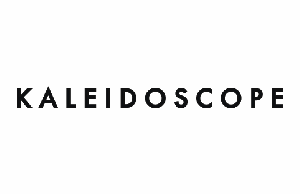
a contemporary magazine
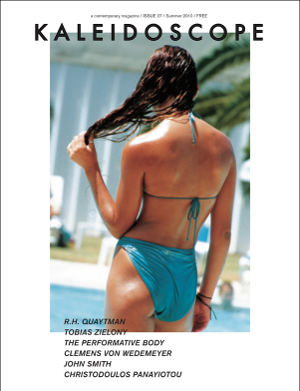
MAIN THEME: THE PERFORMATIVE BODY, featuring: LETTER ON THE DEAF AND MUTE BY YANN CHATEIGNÉ TYTELMAN; Daria Martin by Catherine Wood; Theatrical Insurrection by Francesco Spampinato; A New Economy of Bodies by Pierre Bal-Blanc; Joachim Koester by Lars Bang Larsen.
MONO: Clemens von Wedemeyer. Political Theater by Quinn Latimer; A New Specificity by Giovanni Carmine; On Cinema as Public Space by Manuel Segade.
COLUMNS:
PIONEERS: John Smith by Simone Menegoi;
FUTURA: Christodoulos Panayiotou by Hans Ulrich Obrist;
MAPPING THE STUDIO: Barcelona by Luca Cerizza;
VIA À VIS: DAHN VO AND CAROL BOVE BY ELENA FILIPOVIC;
CRITICAL SPACE: Céline Condorelli by Markus Miessen;
LAST QUESTION by Paul McCarthy.
Torbjørn Rødland
Hanne Mugaas
n. 22 autunno -inverno 2014
John Armleder
Andrea Bellini
n. 21 estate 2014
Voiceover: Under the skin
Shama Khanna
n. 20 inverno 2013-2014
Yang Fudong
Davide Quadrio e Noah Cowan
n. 19 autunno 2013
Massimiliano Gioni
Francesco Manacorda
n. 18 estate 2013
John Currin
Catherine Wood
n. 17 inverno 2012-2013
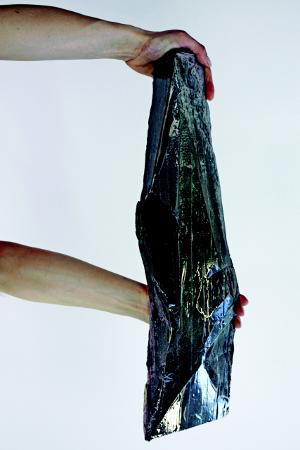
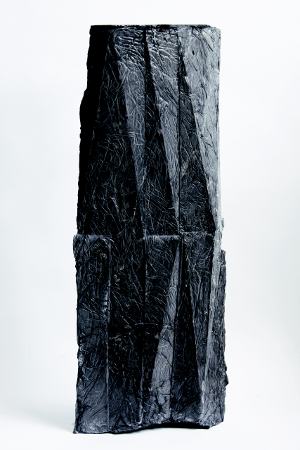
Courtesy the artist and Supportico Lopez Berlin
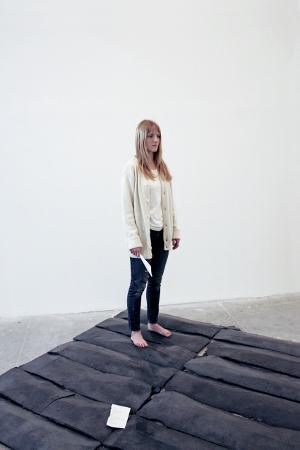
installation view
INDEPENDENT New York 2010
Courtesy the artist
There is something unnatural about writing about the work of Michael Dean. It feels wrong, even criminal. The paradox of this might be obvious to anyone remotely familiar with his sculptures, texts and performances. Dean’s practice begins and ends with language; to deploy a classic structuralist term, it would be difficult to find more “writerly” work than his. For everything he does is a direct byproduct of writing, of language, and it absolutely requires a thoroughly writerly viewing experience—in that it compels an active engagement with the textual underpinnings of the work, in which deciphering is all but indivisible from writing it. Superficially, such work would seem to lend itself with alacrity to an essay. But that is hardly the case: existing on the threshold of language, the work naturally puts up a kind of essential resistance to more conventional syntactical and narrative structures. In other words, writerly as it is, it is not necessarily asking us to have our way with it, on our own terms, but rather to go to it, to meet it at that threshold and engage with it on its own unique, writerly terms.
English, London-based artist Michael Dean is a writer, but not in the traditional sense of the term. He does not write novels, essays or poems, although what he does write is categorically poetic, and can be likened to truncated plays (they do, after all, feature stage directions: curtain, exeunt, etc.) for one or two performers. Furthermore, all the work starts from writing, including the sculptures, whose form is derived from texts, such that the written word is at the origin of everything Dean does. Fragmented, repetitive and occasionally grammatically unsound, his language seems to issue from an intense interiority that borders upon solipsism. Originating if not from a deep intimacy, then from a desire for intimacy, what he writes ambiguously and multifariously functions as an invocation, a command, an observation, a memory and, finally, a demarcation of a lack or absence. Of course, such a description is liable to conjure up an uncomfortable subjectivity on the part of the artist, but Dean’s practice nevertheless tends toward a primeval author-less-ness; it feels timeless the way certain states of being might feel timeless. The personal pronoun “I” is almost never used, and “characters” are never more than disembodied voices, named not “he” or “she,” but merely “voice.” Take, for instance, Dialogue (2009), performed last fall in the Frame section of Frieze (with the assistance of two performers, Dean explosively yelled out the text into the fair). This two-page play consists of two “voices” delivering gnomic pronouncements like “You look up at your left arm and your right hand is under your left hand” or “The face to face with wood and metal when the rains wet metal and wood.” All of these heterogeneous elements, from the body to wood to metal, seem to be organically, and linguistically, sutured together in a discontinuous sensuous continuum. As much could be said about Dean’s numerous books and plays. Phrases often re-appear, cycling through them like motifs, and thus symbolically weaving the texts into one long continuous text. Much of what composed Dialogue can be found, for example, in Dean’s earlier book November to November, self-published in 2008. The book is sectioned into twelve parts—for the months of the year—with long, four- to five-page pauses between them, each of which features a handful of phrases and disjunctive sentences that revolve largely around the theme of reflection (as in a mirror). A whole month might consist of “the face faced,” “the shores is touching” or “my body in the same place as your body.” For all its stark and solemn intimacy, the mood is one of isolated remoteness and longing. The utterances seem to be characterized by a kind of solipsism, perhaps best described by Wallace Stevens in the poem Two Figures in Dense Violet Night, when he writes, “Speak, even, as if I did not hear you speaking, / but spoke for you perfectly in my thoughts,” as if true intimacy could never go beyond an internal dialogue with the self, and the “you” of the outside world were never anything more than the “me” interpreting you, or finally, speaking for you. And yet as damning (to solitude) as such an awareness may sound, it does not necessarily preclude intimacy, but becomes, rather, a prerequisite for it, renders it if not possible, then more possible by stripping away an essential layer of illusion. In the end, one senses from the work that the important thing is a drive toward intimacy—a kind of belief, however fraught, in its possibility.
This drive is embodied, complicated and elegized in the artist’s sculptures. Originally arranging balloons, paper and twigs into abstract linguistic configurations, Dean’s sculptures have recently taken on a more made, as opposed to appropriated, quality, quite literally becoming words set in stone. His recent sculptures are fashioned according to a process by which a word, or a series of words, is translated into a typography invented by the artist. He then makes molds corresponding to this typography and casts concrete sculptures from the molds. Resembling dark tablets with subdued abstract geometric and angular surfaces, the lean objects, which are of varying lengths often analogous to the body and its parts (arms, legs), either lean up against a wall, stand freely, or lay flat on the ground. They can come across as modernist abstractions or ancient artifacts, imbued with the rough and materialistic sensuality of Brancusi and the esoteric allure of hieroglyphics. The words from which they originate, however, have been visibly sublimated into their structure, having long since been rendered illegible through the entire process. What is important here, though, is not that the sculptures should be legible per se, but rather that one should obscurely intuit language among their cryptic contours, that a word or a series of words should only be guessed at, suspected—which is exactly what allows the sculptures to be so writerly, i.e. to become sites of productive engagement, transforming the sculptures into linguistic founts by virtue of their inscribed withdrawal. They seem to demarcate a space in which language, and the communication that attends it, always seems as if they are about to happen—as if they have already happened, are trying to happen again. Thus do the sculptures seem to beckon us to them, the way, say, a whisper beckons, asking to be deciphered (what is more interpretable than a whisper?), even if no deciphering will take place, for it is impossible. As such, they could be said to function, at least to a certain degree, as allegories of human intimacy, which in turn can explain the essential poignancy of this work and, I daresay, its sincerity.
Ah, sincerity: the stuff of expressive taboo that rightfully merits many an unwary art student a most formative drubbing. If sincerity and a total lack of irony after the age of twenty-five is unpardonable to the point of being transgressive, then Dean would seem to be getting away with murder. And this needs to be addressed, not only for its own sake, but also because it can, I think, partially account for the relevance of Dean’s work. It would be ridiculous to try to deny the timeless existential urgency of the subject of human intimacy. Absolutely linked to the vicissitudes and unreliability of language, it is as vast as it is irresolvable; any frontal engagement with it is tantamount to an almost Beckettian commitment to failure. And while the use of irony might soften the potential impact of that failure, it is also liable to obscure the vulnerability essential to any act or hope of true intimacy (I think it’s also important to remember that irony operates by way of a collusion or inclusion that is based on privileged awareness or knowledge. Inclusion is predicated on exclusion, a system that is arguably contrary to the general cause of intimacy.) Irony, finally, would undercut intimacy’s urgency, and rob it of the harried optimism and honesty with which it is suffused in Dean’s work. Or to put it another way, I have never been able to forget a piece of graffiti I saw on a bathroom wall in San Francisco over ten years ago. It read, “The angels in this place are unrecognizable.” And experiencing Michael Dean’s work, I finally understand why.
CHRIS SHARP is Kaleidoscope’s Paris editor. A writer and independent curator based in Paris, he is currently organizing the exhibition “Under Destruction,” co-curated with Gianni Jetzer, which will open in October at the Museum Tinguely in Basel and the Swiss Institute in New York in March 2011, while preparing A Necessarily Incomplete Anthology of Withdrawal, to be published by Archive Books in 2011.


